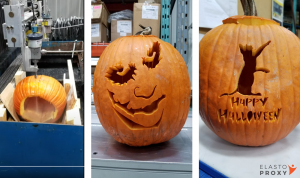Extruded rubber seals support complex cross-sections and have a smooth surface finish. Examples include bulb, lip, door, and accordion seals. These aren’t the only types of extruded rubber products, but they’re used in many applications. They’re also available in various compounds, durometers, shapes, sizes, and colors.
Bulb, lip, door, and accordion seals are supplied in standard lengths of sponge or solid rubber. These lengths are cut-to-size and then spliced or bonded into finished gaskets. Elasto Proxy’s Extruded Rubber Products catalog describes some of the hundreds of rubber profiles that we keep in stock and can custom-fabricate for you.
Let’s take a closer look at what you need to know about these four main types of extruded rubber seals.
Bulb Seals
Bulb seals have an open, rounded, or teardrop-shaped section that supports compression. Some bulbs have a rounded section that looks like a half-moon with a flat bottom instead. Bulb seal dimensions vary, but generally include height, inner diameter (ID), and outer diameter (OD). Often, bulb seals are installed between doors and door frames in vehicles or buildings.
To support compression, bulb seals are usually made of sponge rubber. Softer bulbs made of materials such as EPDM foam can create a watertight seal. With mobile equipment, bulb seals can be attached to metal surfaces such as frames with strong, weather-resistant tape. These tapes can provide either temporary or permanent fastening.
Lip Seals
Lip seals feature an edge or sealing lip and, in some cases, an opening. Often, these extruded rubber seals are used to protect the bearing that supports a rotating shaft or bore. Rotary shaft seals, a type of lip seal, retain the bearing’s lubricant and help to prevent the ingress of dust, dirt, and other contaminants that can impede performance or shorten bearing life.
Radial lip seals are used in high-speed crankshaft applications for diesel and gasoline engines. These extruded rubber seals are also used in other types of vehicles and with pumps, mills, and industrial equipment. Compounds vary in terms of material properties, so it’s important to choose an oil-resistant rubber if required by your application.
Door Seals
Door seals are designed to fill the gaps between doors and door frames in vehicles or buildings. Depending on the application environment, these extruded rubber seals may need to resist wind, water, weather, or a wide range of temperatures. Applications include mobile equipment, military vehicles, and residential and commercial construction.
Door seals are generally defined by their application rather than by geometric features or material composition. However, most door seals are rectangular. Hatch seals, a type of door seal, are used with fuel tanks, electronic enclosures, and rooftop HVAC systems. This category of extruded rubber seals includes custom weather stripping and some types of bulb seals.
Accordion Seals
Accordion seals have folds like the bellows of an accordion. Consequently, the physical dimensions for these extruded rubber seals are very different when they’re stretched or compressed. Many accordion seals are made of EPDM rubber because this elastomer imparts weather and abrasion resistance. Some products also feature an internal spring steel loom.
Accordion seals are often used with mobile equipment and other transportation-related applications. For example, accordion boot seals are used to weatherproof access points such as between a truck cab and a trailer. Without this type of sealing, the splash of water from roadways may cause or contribute to the formation of rust.
How Can We Help You?
Do you need bulb seals, lip seals, door seals, or accordion seals? Would you like to see drawings of standard rubber products that Elasto Proxy can custom-fabrication into specialty sealing solutions? To learn more, download the Extruded Rubber Products Catalog.









